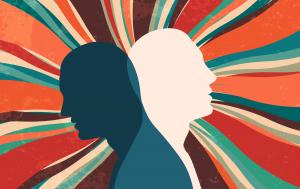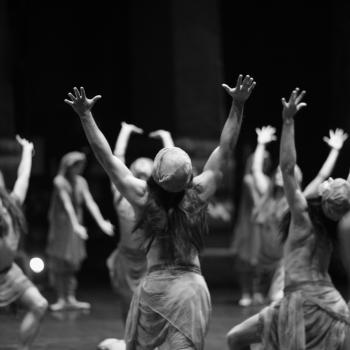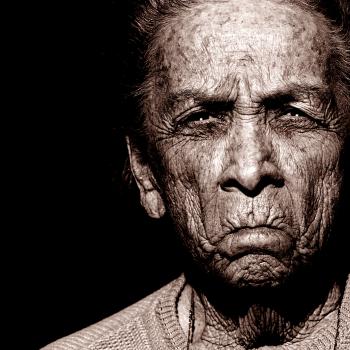 Earlier this year, I published an article in Zygon: The Journal of Religion and Science, part of a special issue on new developments in the scientific study of religion. The article is an argument for a new (or, really, a renewed) way of understanding and explaining religious experience. Drawing from recent work in social cognitive science as well as classical theories in anthropology, I make the case that religious experiences result from the oscillation between social structure or institutions and the more immediate, personal dimensions of bodily life, with ecstatic dance and drumming as a test case for the framework.
Earlier this year, I published an article in Zygon: The Journal of Religion and Science, part of a special issue on new developments in the scientific study of religion. The article is an argument for a new (or, really, a renewed) way of understanding and explaining religious experience. Drawing from recent work in social cognitive science as well as classical theories in anthropology, I make the case that religious experiences result from the oscillation between social structure or institutions and the more immediate, personal dimensions of bodily life, with ecstatic dance and drumming as a test case for the framework.
Over the past two decades, the cognitive and evolutionary sciences of religion have generally focused on trying to explaining religious beliefs and rituals, paying only occasional attention to religious experience. Religious experiences are famously difficult to define, after all. The psychologist-cum-philosopher William James identified “ineffability” – the incapacity to put something into words – as one of their core features.
Not all subjective experiences are so inaccessible. Third parties can agree on and take measurements of the objective correlates of basic experiences, such as seeing a scary image, using skin conductance reactivity or altered blood flow to the brain’s visual cortex. Following this strategy, some researchers have examined subjects in brain scanners during meditation or prayer, but this method runs into a different kind of problem. It’s not hard to show someone a picture of a movie monster so as to activate the neural circuitry for fear, but it is hard to have a profound mystical or transcendent experience on command. So even with advanced techniques of brain research, religious experiences are particularly hard to study.
Yet they’re crucially important for understanding religious life. Medieval Christianity, for instance, wouldn’t have been the same without the ecstatic visions of eccentrics and monastics like Hildegard of Bingen. These mystics made Christianity seem credible and vital, boosting the Church’s emotional hold on everyday people through their writings and sermons. The course of subsequent world history might have been very different without Hildegard and people like her. Somehow or another, we need to be able to take religious experience into account.
But how? One influential scholar, Ann Taves, has argued that predictive processing models of the mind can help us understand religious experiences. Other cognitive scientists and neuroscientists have taken up this challenge, showing how religious rituals and experiences might result from mismatches between the brain’s predictions and incoming sensory data.
Taves’ approach is addressed to religious experiences of all kinds, from the most profound flights of ecstasy to humdrum, absent-minded mumbling through daily prayers. What I was interested in, though, was specifically religiously interpreted altered states of consciousness (ASCs), or “religious ASCs.” Religious ASCs are profoundly arresting, usually relatively short-lived experiences characterized by shifts in perception, affect, and experience of time or self.
Of course, the consensus in religious studies is that mystical or religious experiences aren’t natural kinds, but rather are the result of cultural and personal interpretations of many different, heterogeneous kinds of experience. Some people might interpret a psilocybin trip or other anomalous experience as a mystical encounter, while others just think it’s a good time. In my paper, then, I apply the predictive processing framework specifically to ASCs that experiencers interpret as being religiously or spiritually important. The question becomes: what leads people to interpret some ASCs as religiously relevant?
To answer this question, I turned to Émile Durkheim, one of the founders of sociology, and Victor Turner, a major figure in 20th-century anthropology. Durkheim is famous for introducing the concept of homo duplex – the tension between the physical or biological aspect of humanity, on one hand, and its social or normative aspects on the other. For Durkheim, society and its rules existed on a more permanent, abstract level than flesh and blood. Social norms and roles structured and constrained people’s behavior in ways not reducible to individual goals or desires. Yet because the individual bodies of people retained their own motivations – for food, sex, pleasure, recreation, etc. – an inevitable conflict existed between society’s demands and people’s biological, organismic nature.
Building on Durkheim’s work, Victor Turner posited that every society vacillated between the normative social structure that dominated everyday life and more egalitarian, transitional moments when people come together as a collective. Turner called this the “ritual process,” and labeled the transient periods of togetherness communitas.
But communitas didn’t just mean warm feelings of togetherness. In many ways, it meant a shift toward the organismic side of Durkheim’s homo duplex, where social statuses and coverings were (either symbolically or literally) stripped away to reveal the vulnerable human animals beneath. Reduced to their raw animal nature, participants in rituals of communitas could share personal connections that cut across normal distinctions of status. Turner calls this abnegation of everyday roles “antistructure” – the inverse of social structure.
What my paper argues is that Durkheimian or Turnerian social structure is the world of conventional expectations, norms, and roles, and the fine-grained actions we take to reinforce them. Drawing on predicting coding models of the brain, I argue that dealing with social structure require extensive social cognition. If you and I have a structural interaction, we have to keep track of conventions and norms in order to successfully anticipate one another’s actions and decisions, and we have to draw complex inferences about what each of us believes about the other’s social identity, motives, responsibilities, and so on.
In other words, we have to know – have a model of – what structural roles we each inhabit. If I’m a landlord and you’re a renter, then we each bring into our interactions a set of expectations about how landlords and renters are supposed to act, what their respective obligations and rights are, and so forth. These normative expectations allow us to predict our own and each other’s behavior.
Where I go beyond Durkheim and Turner is by narrowing the focus from the social-theoretical level to the cognitive and empirical one, raising hypotheses about what’s going on in the brain during moments of communitas and antistructure. To begin with, research in social psychology and cognitive motor science suggests that social-structural interactions often call for complementary turn-taking behaviors. While we typically mirror the postures and gestures of people we feel close to, normative role differences can lead us to expect different postures and to speak or act in turn rather than on the same beat.
Let’s take a real-world example. South Korea, a deeply Confucian society with strong norms about social roles, has historically placed significant constraints on people’s behavior according to their position in society. From the Zygon article:
In highly structured Korean Confucian society, an everyday interaction between a woman and her father-in-law is likely to be heavily templated. The normative behaviors differ by role, so that actors’ motor sequences are complementary rather than identical…. The wife might, for instance, turn away slightly from her father-in-law when drinking from a cup to indicate respect.
But Korean society also offers moments of communitas, as all societies do. The most dramatic of these may be the dramatic, gong-banging, alcohol-soaked rituals of the local (overwhelmingly female) Manshin shamans. During a shamanic ceremony,
loud, rhythmically banging drums and perhaps alcohol downregulate complex social prediction while sometimes producing trance…. During rhythm-induced trance and consequent ASCs, then, participants’ behavioral motives transition from (1) conventional templates that centralize others’ intentional mental states to (2) immediate motivational sources such as intrinsic urges to move in time with socially produced auditory rhythms.
In other words, during communitas people use less social cognition, as their attention becomes focused less on the normative layer of social reality and more on what analytic philosophers call “brute facts,” including direct sensory experiences: the rhythm of the music, the colorful tangle of the opulently decorated altar. As attention moves away from social norms and everyday roles, socio-motor behavior shifts from largely being complementary to being more convergent. Participants dance or sway to the same gong rhythm, rather than (for example) carefully turning their heads away from social superiors to show respect.
Another way to express this point is to say that antistructure entails a transition away from what the philosopher and economist Carsten Herrmann-Pillath calls “semiotic” motivations to what he terms “efficient-causal” motivations.
Semiotic motivations are reasons for actions that make reference to abstract social values, norms, or institutions – that is, shared understandings that can only be communicated fully in words. (Hence the “semiotic” moniker.) When you put on an uncomfortable suit before a job interview, you’re operating according to semiotic motivations. You know that the interviewers will expect you to be wearing proper attire, and that you’ll face consequences if you don’t do so. Semiotic motivations, then, require people to keep mental track of multiple layers of social cause and effect, extended iteratively into the future.
By contrast, efficient-causal motivations make reference to immediate physiological states or drives. If you’re hungry, the motive to eat comes from internal bodily sensations. If you touch a hot pan, the motivation to jerk your hand away comes from electrochemical signals pulsing into your central nervous system, translated by your brain into the experience of pain. Unlike semiotic motivations, we don’t need to draw on social cognition to act according to efficient-causal motives. Social norms, obligations, or consequences aren’t the instigators for action.
My central argument in the paper is that semiotic motivations are likely to be inversely correlated with religious ASCs. By inference, we should expect religious ASCs to be associated with more focus on intrinsic bodily motivations and brute physical facts. This might sound counterintuitive to those who think religion – and, by inference, religious experience – is about some purely spiritual, nonphysical level of reality. But the dichotomy we derive from Durkheim isn’t “spiritual/good vs. physical/bad.” It’s more like “social/abstract/normative vs. individual/concrete/immediate.”
Profound religious experiences are almost always described in intensely individual terms – even when they take place in a group setting, such as a trance dance. That’s why it makes sense to place religious ASCs closer to the “individual/concrete/immediate” pole of this continuum.
Experiences of antistructure – whether during an ecstatic, shamanistic drumming ceremony or a quiet vespers in a muted chapel – are, then, where we should be looking for the kinds of bottom-up perceptual and motivational experiences that are most likely to be interpreted as religious or spiritual in nature.
If it tracks reality, this theoretical framework helps account for a few of the most puzzling aspects of religious ASCs, including that they’re subjectively undeniable (they feel absolutely convincing to those who experience them), are often associated with what I call “gross physiological motifs,” and are susceptible to intentional manipulation.
Undeniability parallels the difference between semiotic motivations, which reference abstract social states, and efficient-causal motivations, which are rooted in direct, undeniable physiological facts. Antistructural moments tend to emphasize things that can’t be denied, or which aren’t cultural constructions: instead of occupying made-up roles, we feel directly impelled to move to a drumbeat or are directly influenced by an intoxicant. Hence, antistructural moments often feature strongly physiological and organismic motifs, such as nudity (as during many societies’ initiation rites) or feasting or fasting, or strong sensory experiences, such as compelling music or pungent aromas.
This strong bias toward organismic motifs in turn implies that we can actively work to elicit religious ASCs by pursuing or crafting experiences that emphasize the organismic and the efficient-causal domains, while downplaying the social-structural and semiotic ones. Most cultures wind up hitting on this insight, using means such as fasting, ecstatic drumming, or psychoactive drugs to “dial down” the semiotic channel of motivation.
Who knows whether I’m right about this? Is the continuum between social structure and organismic antistructure really the key to understanding why some profound experiences get tagged as “religious” while others don’t? If I’m being honest, it’s probably nowhere near that simple. Better minds than mine have worked on this problem for decades and haven’t come up with a solution. But the framework I propose is generative: it leads to predictions, and predictions guide research and shape future inquiry. For example, if rhythmic dance leads to antistructure, then it should also lead participants to temporarily become less invested in, or to place less stock in, social constructs such as social roles, norms, or even (potentially) political borders.
If you take the view of religions or cultures as being complex adaptive systems, then this Turnerian pivoting between firm social boundaries and brute physiological facts may inject the flexibility needed for cultural change. The anthropologist and trance expert Erika Bourguignon observed that
(W)hen we consider the relationship of religion to change, its double role as a bulwark against change on the one hand and as a mediator or even initiator of change on the other, we often find that key individuals in this process experience altered states of consciousness.
I conclude the paper paper by circling back to the social level where I began. The middle of the paper describes the granular cognitive markers that distinguish between semiotic, role-based motives and efficient-causal ones. But these cognitive processes turn out to be the very mechanisms by which social groups change and adapt themselves at the group level. Religious experiences are some of the most profound and personal experiences we can have, but they’re only fully intelligible in light of the social context in which all individuals live.
Click here to check out the full paper, “Antistructure and the Roots of Religious Experience” at Zygon: The Journal of Religion and Science. Thanks to Lluís Oviedo, SJ, for editing the special issue and soliciting my and other authors’ contributions. You can see the other articles in the issue, including pieces by Robert McCauley, Konrad Szocik, Léon Turner, and Hans Van Eyghen, here.












